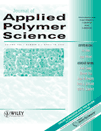Paste extrusion of polytetrafluoroethylene (PTFE) powders through tubular and annular dies at high reduction ratios
Abstract
Paste extrusion experiments are reported for three different polytetrafluoroethylene (PTFE) fine powders using both capillary and annular dies having a high reduction ratio (cross-sectional area of reservoir to cross-sectional area of die at the exit) varied from 1000 up to 4000. The extrusion pressure is reported as a function of the apparent shear rate for various resins and dies. The approximate mathematical model for paste extrusion through capillary dies developed by Ariawan et al. (Ariawan et al., Can Chem Eng J, 2002, 80, 1153) was used to describe the experimental data by best fitting the five material constants of the constitutive model. Using these constants, the model developed by Patil et al. (Patil et al., AIChE J., 2006, 52, 4028) was used to predict the extrusion pressure for all three resins in annular dies. The model predictions are found to be consistent with experimental results and the analogy between the rod and tube extrusion models is demonstrated. © 2008 Wiley Periodicals, Inc. J Appl Polym Sci, 2008




